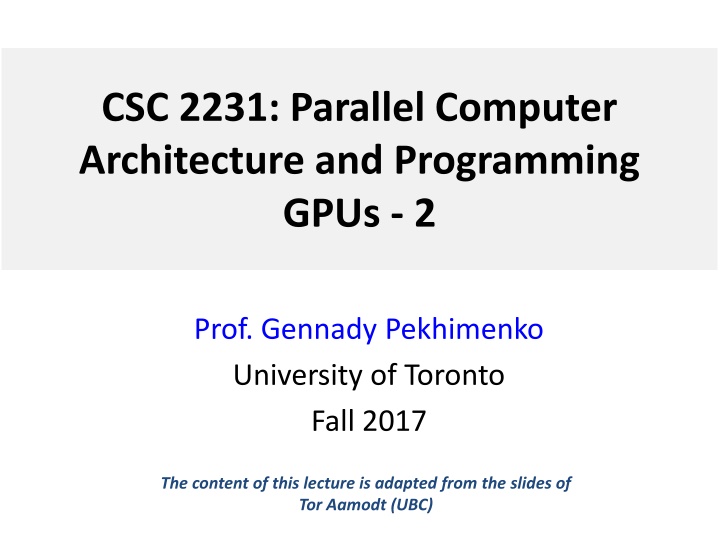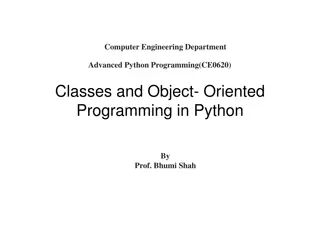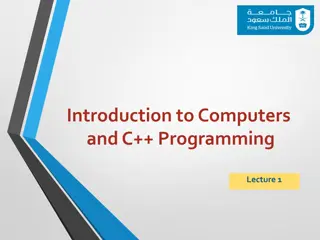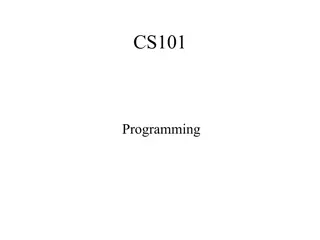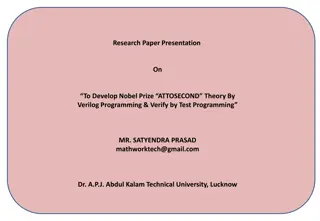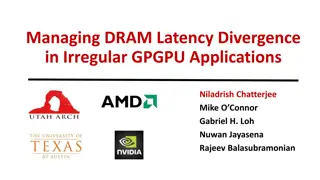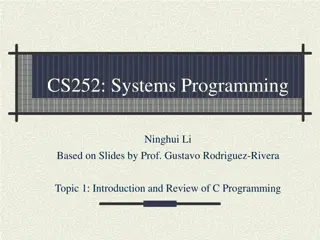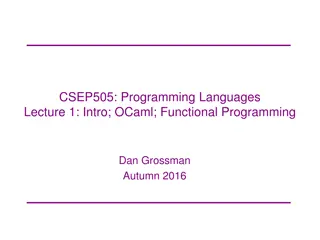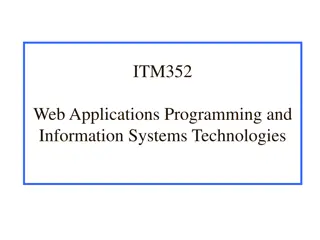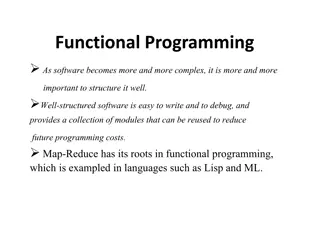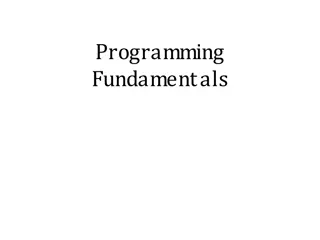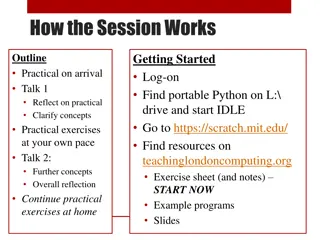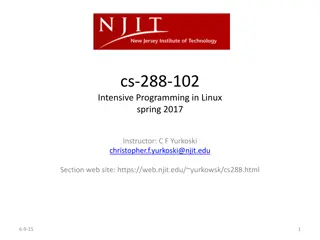GPGPU Programming Model Overview
This lecture adapted from University of Toronto covers parallel computer architecture and programming with GPUs, discussing similarities between GPGPUs and vector processors, introducing the GPGPU programming model, resources for GPGPU programming, and the CUDA/OpenCL threading model.
Download Presentation

Please find below an Image/Link to download the presentation.
The content on the website is provided AS IS for your information and personal use only. It may not be sold, licensed, or shared on other websites without obtaining consent from the author.If you encounter any issues during the download, it is possible that the publisher has removed the file from their server.
You are allowed to download the files provided on this website for personal or commercial use, subject to the condition that they are used lawfully. All files are the property of their respective owners.
The content on the website is provided AS IS for your information and personal use only. It may not be sold, licensed, or shared on other websites without obtaining consent from the author.
E N D
Presentation Transcript
CSC 2231: Parallel Computer Architecture and Programming GPUs - 2 Prof. Gennady Pekhimenko University of Toronto Fall 2017 The content of this lecture is adapted from the slides of Tor Aamodt (UBC)
Course Agenda Presenters, please, send me your slides Course evaluations next week: Please bring laptop, ipad, smartphone to do it in class (10-15 mins max) Poster presentations: Dec. 1st after class (I know it is a bit late ) Different day (?) 2
Review #8 Sequoia: Programming the Memory Heirarchy Kayvon Fatahalian et al., Supercomputing 2006 Due Nov. 24 3
Review #7 Results Grades (out of 10) Mean: 9.06 10 9 8 7 6 5 4 3 2 1 0 1 2 3 4 5 4
GPGPUs vs. Vector Processors Similarities at hardware level between GPU and vector processors. (I like to argue) SIMT programming model moves hardest parallelism detection problem from compiler to programmer. 5
Part 1: Introduction to GPGPU Programming Model 6
GPGPU Programming Resources Kirk and Hwu, Programming Massively Parallel Processors, Morgan Kaufmann, 2nd edition, 2014 (NOTE: 2nd edition includes coverage of OpenCL, C++AMP, and OpenACC) 7
GPU Compute Programming Model CPU GPU How is this system programmed (today)? 1.8
GPGPU Programming Model + CPU Off-load parallel kernels to GPU CPU CPU CPU spawn spawn done GPU GPU Time Transfer data to GPU memory GPU HW spawns threads Need to transfer result data back to CPU main memory 9
CUDA/OpenCL Threading Model CPU spawns fork-join style grid of parallel threads kernel() thread block N thread block 0 thread block 1 thread grid Spawns more threads than GPU can run (some may wait) Organize threads into blocks (up to 1024 threads per block) Threads can communicate/synchronize with other threads in block Threads/Blocks have an identifier (can be 1, 2 or 3 dimensional) Each kernel spawns a grid containing 1 or more thread blocks. Motivation: Write parallel software once and run on future hardware 10
SIMT Execution Model Programmers sees MIMD threads (scalar) GPU bundles threads into warps (wavefronts) and runs them in lockstep on SIMD hardware An NVIDIA warp groups 32 consecutive threads together (AMD wavefronts group 64 threads together) Aside: Why Warp ? In the textile industry, the term warp refers to the threads stretched lengthwise in a loom to be crossed by the weft [Oxford Dictionary]. Jacquard Loom => Babbage s Analytical Engine => => GPU. [https://en.wikipedia.org/wiki/Warp_and_woof] 1.11
SIMT Execution Model Challenge: How to handle branch operations when different threads in a warp follow a different path through program? Solution: Serialize different paths. foo[] = {4,8,12,16}; A T1 T2 T3 T4 A: v = foo[threadIdx.x]; B: if (v < 10) B T1 T2 T3 T4 C: v = 0; Time C T1 T2 else D T3 T4 D: v = 10; E E: w = bar[threadIdx.x]+v; T1 T2 T3 T4 1.12
CUDA Syntax Extensions Declaration specifiers __global__ void foo(...); // kernel entry point (runs on GPU) __device__ void bar(...); // function callable from a GPU thread Syntax for kernel launch foo<<<500, 128>>>(...); // 500 thread blocks, 128 threads each Built in variables for thread identification dim3 threadIdx; dim3 blockIdx; dim3 blockDim; 1.13
Example: Original C Code void saxpy_serial(int n, float a, float *x, float *y) { for (int i = 0; i < n; ++i) y[i] = a*x[i] + y[i]; } int main() { // omitted: allocate and initialize memory saxpy_serial(n, 2.0, x, y); // Invoke serial SAXPY kernel // omitted: using result }
CUDA Code __global__ void saxpy(int n, float a, float *x, float *y) { int i = blockIdx.x*blockDim.x + threadIdx.x; if(i<n) y[i]=a*x[i]+y[i]; } Runs on GPU int main() { // omitted: allocate and initialize memory int nblocks = (n + 255) / 256; cudaMalloc((void**) &d_x, n); cudaMalloc((void**) &d_y, n); cudaMemcpy(d_x,h_x,n*sizeof(float),cudaMemcpyHostToDevice); cudaMemcpy(d_y,h_y,n*sizeof(float),cudaMemcpyHostToDevice); saxpy<<<nblocks, 256>>>(n, 2.0, d_x, d_y); cudaMemcpy(h_y,d_y,n*sizeof(float),cudaMemcpyDeviceToHost); // omitted: using result }
OpenCL Code __kernel void saxpy(int n, float a, __global float *x, __global float *y) { int i = get_global_id(0); if(i<n) y[i]=a*x[i]+y[i]; } Runs on GPU int main() { // omitted: allocate and initialize memory on host, variable declarations int nblocks = (n + 255) / 256; int blocksize = 256; clGetPlatformIDs(1, &cpPlatform, NULL); clGetDeviceIDs(cpPlatform, CL_DEVICE_TYPE_GPU, 1, &cdDevice, NULL); cxGPUContext = clCreateContext(0, 1, &cdDevice, NULL, NULL, &ciErr1); cqCommandQueue = clCreateCommandQueue(cxGPUContext, cdDevice, 0, &ciErr1); dx = clCreateBuffer(cxGPUContext, CL_MEM_READ_ONLY, sizeof(cl_float) * n, NULL, &ciErr1); dy = clCreateBuffer(cxGPUContext, CL_MEM_READ_WRITE, sizeof(cl_float) * n, NULL, &ciErr1); // omitted: loading program into char string cSourceCL cpProgram = clCreateProgramWithSource(cxGPUContext, 1, (const char **)&cSourceCL, &szKernelLength, &ciErr1); clBuildProgram(cpProgram, 0, NULL, NULL, NULL, NULL); ckKernel = clCreateKernel(cpProgram, saxpy_serial , &ciErr1); clSetKernelArg(ckKernel, 0, sizeof(cl_int), (void*)&n); clSetKernelArg(ckKernel, 1, sizeof(cl_float), (void*)&a); clSetKernelArg(ckKernel, 2, sizeof(cl_mem), (void*)&dx); clSetKernelArg(ckKernel, 3, sizeof(cl_mem), (void*)&dy); clEnqueueWriteBuffer(cqCommandQueue, dx, CL_FALSE, 0, sizeof(cl_float) * n, x, 0, NULL, NULL); clEnqueueWriteBuffer(cqCommandQueue, dy, CL_FALSE, 0, sizeof(cl_float) * n, y, 0, NULL, NULL); clEnqueueNDRangeKernel(cqCommandQueue, ckKernel, 1, NULL, &nblocks, & blocksize, 0, NULL, NULL); clEnqueueReadBuffer(cqCommandQueue, dy, CL_TRUE, 0, sizeof(cl_float) * n, y, 0, NULL, NULL); 16 // omitted: using result }
C++AMP Example Code #include <amp.h> usingnamespace concurrency; int main() { // omitted: allocation and initialization of y and x array_view<int> xv(n, x); array_view<int> yv(n, y); parallel_for_each(yv.get_extent(), [=](index<1> i) restrict(amp) { yv[i] = a * xv[i] + yv[i]; }); yv.synchronize(); // omitted: using result } Runs on GPU
OpenACC Example Code void saxpy_serial(int n, float a, float *x, float *y) { #pragma acc kernels for (int i = 0; i < n; ++i) y[i] = a*x[i] + y[i]; } Runs on GPU
GPU Memory Address Spaces GPU has three address spaces to support increasing visibility of data between threads: local, shared, global In addition two more (read-only) address spaces: Constant and texture. 19
Local (Private) Address Space Each thread has own local memory (CUDA) private memory (OpenCL). 0x42 Note: Location at address 100 for thread 0 is different from location at address 100 for thread 1. Contains local variables private to a thread. 20
Global Address Spaces Each thread in the different thread blocks (even from different kernels) can access a region called global memory (CUDA/OpenCL). thread block X thread block Y Commonly in GPGPU workloads threads write their own portion of global memory. Avoids need for synchronization slow; also unpredictable thread block scheduling. 0x42 21
History of global memory Prior to NVIDIA GeForce 8800 and CUDA 1.0, access to memory was through texture reads and raster operations for writing. Problem: Address of memory access was highly constrained function of thread ID. CUDA 1.0 enabled access to arbitrary memory location in a flat memory space called global 22
Example: Transpose (CUDA SDK) __global__ void transposeNaive(float *odata, float* idata, int width, int height) { int xIndex = blockIdx.x * TILE_DIM + threadIdx.x; // TILE_DIM = 16 int yIndex = blockIdx.y * TILE_DIM + threadIdx.y; 1 2 1 3 int index_in = xIndex + width * yIndex; int index_out = yIndex + height * xIndex; for (int i=0; i<TILE_DIM; i+=BLOCK_ROWS) { // BLOCK_ROWS = 16 odata[index_out+i] = idata[index_in+i*width]; } } 3 4 2 4 NOTE: xIndex , yIndex , index_in , index_out , and i are in local memory (local variables are register allocated but stack lives in local memory) odata and idata are pointers to global memory (both allocated using calls to cudaMalloc -- not shown above) 23
Coalescing global accesses Not same as CPU write combining/buffering: Aligned accesses request single 128B cache blk 128 255 ld.global r1,0(r2) Memory Divergence: 128 1152 256 1024 ld.global r1,0(r2) 24
Example: Transpose (CUDA SDK) __global__ void transposeNaive(float *odata, float* idata, int width, int height) { int xIndex = blockIdx.x * TILE_DIM + threadIdx.x; int yIndex = blockIdx.y * TILE_DIM + threadIdx.y; int index_in = xIndex + width * yIndex; int index_out = yIndex + height * xIndex; for (int i=0; i<TILE_DIM; i+=BLOCK_ROWS) { odata[index_out+i] = idata[index_in+i*width]; } } Assume height=16 and consider i=0: Thread x=0,y=0 has xIndex=0, yIndex=0 so accesses odata[0] Thread x=1,y=0 has xIndex=1, yIndex=0 so accesses odata[16] Write to global memory highlighted above is not coalesced . 25
Redundant Global Memory Accesses __global__ void matrixMul (float *C, float *A, float *B, int N) { int xIndex = blockIdx.x * BLOCK_SIZE + threadIdx.x; int yIndex = blockIdx.y * BLOCK_SIZE + threadIdx.y; float sum = 0; for (int k=0; k<N; i++) sum += A[yIndex][k] * B[k][xIndex]; C[yIndex][xIndex] = sum; } E.g., both thread x=0,y=0 and thread x=32, y=0 access A[0][0] potentially causing two accesses to off-chip DRAM. In general, each element of A and B is redundantly fetched O(N) times. 26
CSC 2231: Parallel Computer Architecture and Programming GPUs - 2 Prof. Gennady Pekhimenko University of Toronto Fall 2017 The content of this lecture is adapted from the slides of Tor Aamodt (UBC)
